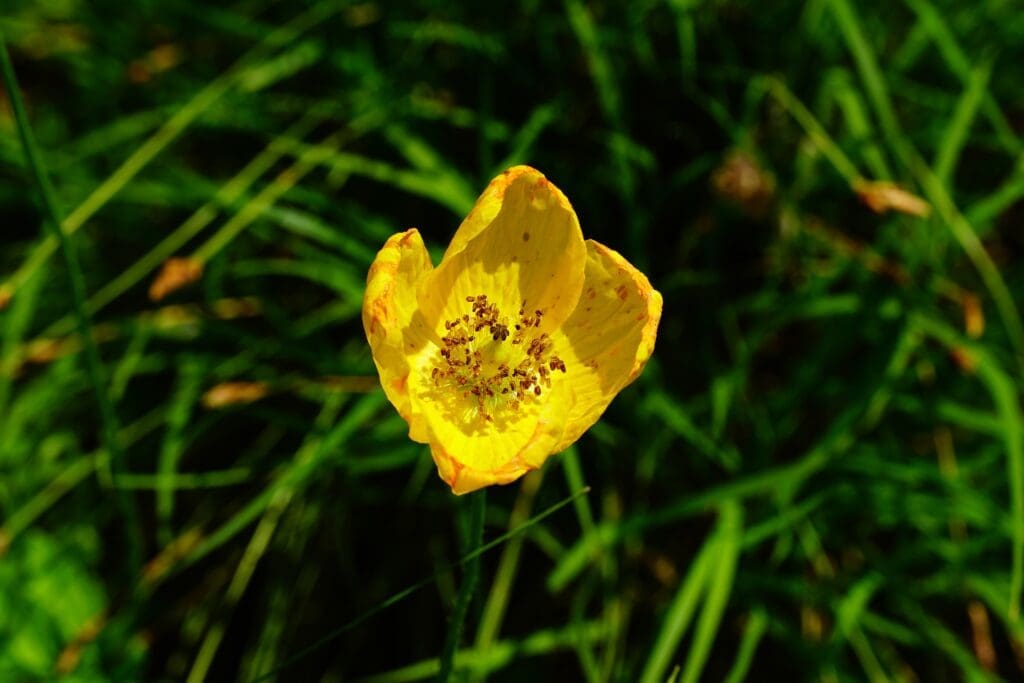
Ranunculus bulbosus
Latin name: Ranunculus bulbosus
Short name: Ran-b
Common name: Bulbous Buttercup | St. Anthony's Turnip | Crowfoot | Bulbous Crowfoot | Butterflower
Primary miasm: Sycotic Secondary miasm(s): Psoric
Kingdom: Plants
Family: Ranunculaceae
- Symptomatology
- Remedy Information
- Differentiation & Application
Ranunculus bulbosus is a member of the Ranunculaceae (buttercup) family, known for its acrid, blistering sap. It grows in meadows and fields, flowering in spring. The bulb and plant contain volatile acrid juices that, in their crude form, irritate skin and mucosa. In homeopathy, it is a remedy with strong action on the skin, muscles, serous membranes, and chest, particularly suited to intercostal rheumatism, shingles, and pleurodynia.
In folk medicine, the bruised plant was historically applied to joints or used to raise blisters. Otherwise avoided due to its toxic blistering properties.
Proven by Hahnemann; further symptoms developed through toxicological effects and clinical confirmations by Hering and others
- Skin – eruptions, vesicles, itching, burning, herpes zoster
- Chest and pleura – intercostal muscles, stitching pain, pleuritic conditions
- Serous membranes – pleura, peritoneum
- Muscles and fibrous tissue – soreness, rheumatism, myalgia
- Eyes – neuralgia around the orbit
- Scalp and head – crusty eruptions, sensitive to touch
- Nervous system – pain with numbness and vesicular eruptions
- Rest
- Lying on the back
- Cold applications (in some skin complaints)
- Pressure (on chest pains)
- Open air (sometimes)
- Changes in weather, especially damp or stormy weather
- Cold air and drafts
- Motion, especially of arms or chest
- Evening and at night
- Touch
- Alcohol or emotional excitement
- Suppression of eruptions
- Rhus toxicodendron – Similar vesicular eruptions, worse from rest and damp; more restlessness
- Bryonia – Stitching chest pain worse from motion, but less skin involvement
- Apis mellifica – Burning, stinging skin with swelling; more oedema and thirstlessness
- Arsenicum album – Burning eruptions, restlessness, but more systemic and anxious
- Mezereum – Herpetic eruptions with neuralgia and crusting, but more bone pain and facial eruptions
- Sulphur – Skin eruptions with burning, but more offensive discharges and general heat
- Complementary: Bryonia, Rhus tox
- Antidotes: Camphora, Nux vomica
- Follows well: Sulphur, Pulsatilla (after suppression)
- Inimical: Phosphorus (antagonistic weather modality)
Ranunculus bulbosus embodies the hyperirritability of skin and serous membranes. Pain is sharp, stitching, and localised, arising from the suppression of eruptions, exposure to damp air, or emotional strain. The keynote is sensitivity—to touch, weather, and emotion. The patient may be irritable, restless, and preoccupied with bodily discomfort, which is often out of proportion to objective findings. It suits those who suffer from recurring herpes, intercostal pains, and skin conditions that flare with weather changes.
- First choice in intercostal neuralgia, especially post-herpetic
- Excellent in shingles when vesicles burn and sting
- Consider in pleurodynia with sharp, cutting pain worse from motion
- Useful in weather-sensitive eczema or scalp eruptions
- Can be beneficial in chronic rheumatism where weather aggravates
Skin
- Eruptions, vesicular
- Itching, burning, stinging
- Herpes zoster
- Sensitive to cold air
Chest
- Pain, intercostal
- Pain, stitching, motion agg.
- Pleurisy, muscular
Mind
- Irritability
- Anxiety with skin eruptions
- Brooding
Extremities
- Pain, rheumatic
- Tingling, hands
- Eczema of fingers
Back
- Pain, between scapulae
- Pain, dorsal spine
Generalities
- Weather changes aggravate
- Worse damp, cold air
- Suppressed eruptions, from
- Samuel Hahnemann – Materia Medica Pura: Provided core proving data, especially intercostal and skin symptoms
- C. Hering – Guiding Symptoms: Expanded on herpes, neuralgia, and chest pain modalities
- J.H. Clarke – Dictionary of Practical Materia Medica: Rich details on skin, pleura, and muscular involvement
- Boericke – Pocket Manual of Homoeopathic Materia Medica: Practical indications for chest and skin affections
- T.F. Allen – Encyclopaedia of Pure Materia Medica: Comprehensive proving and toxicological profiles
